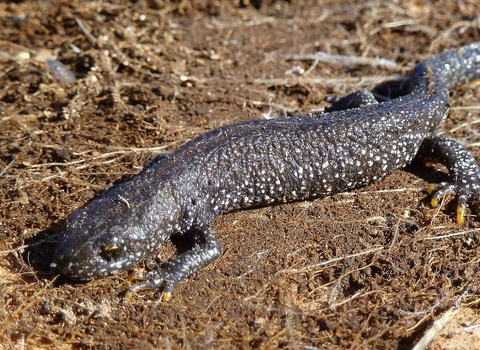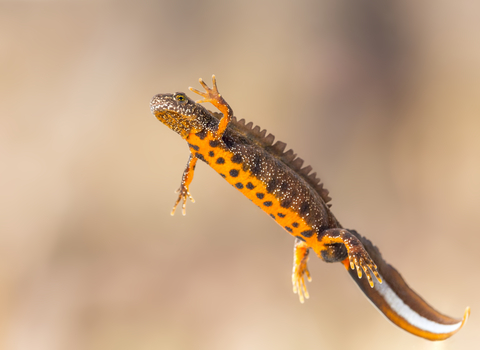
©Joy Russell
Great crested newt
Scientific name
Triturus cristatusWhen to see
March to OctoberSpecies information
Category
Statistics
Length: up to 17cmAverage lifespan: 6-15 years
Habitats
About
Newts are amphibians, breeding in ponds during the spring and spending most of the rest of the year feeding on invertebrates in woodland, hedgerows, marshes and tussocky grassland. They hibernate underground, among tree roots and in old walls. The UK's populations of the great crested newt are internationally important.How to identify
Our biggest newt, the great crested newt is almost black in colour, with spotted flanks and a striking, orange belly. It has warty skin and males have a long, wavy crest along the body and tail during the breeding season.Distribution
Widespread across lowland England and Wales.In our area
Newts are found across the county. Prolific populations were found a couple of years ago at the old canal at Telford Way, Shrewsbury, which runs parallel to Sundorne Road.
They can also be seen in garden ponds, shallow lakes and disused canals. A good place to spot them in Telford is in the old canal basin in Granville Country Park...look for the bubbles rising to the surface as an indicator of newt activity!
Did you know?
Individual great crested newts can be identified by looking at their bellies as the pattern of black spots they each sport is as unique as a fingerprint. As well as their distinctive crests, males have an extravagant courtship display to woo females: they stand on their front legs, arch their back and wave their tail around as if they are dancing.Newts are found across the county. Prolific populations were found a couple of years ago at the old canal at Telford Way, Shrewsbury, which runs parallel to Sundorne Road.
They can also be seen in garden ponds, shallow lakes and disused canals. A good place to spot them in Telford is in the old canal basin in Granville Country Park...look for the bubbles rising to the surface as an indicator of newt activity!

